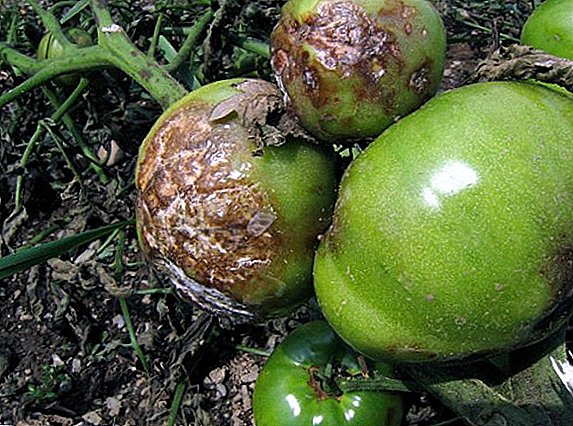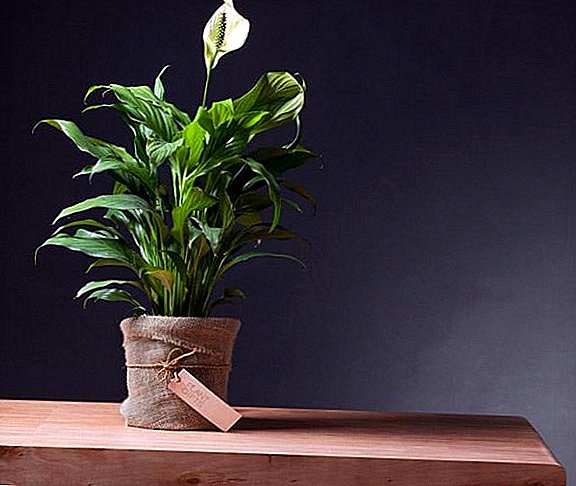 Many housewives ask themselves: what ways can be propagated ficus. Quite often in the breeding time mistakes are made, because of what young plants do not take root or grow very poorly.
Many housewives ask themselves: what ways can be propagated ficus. Quite often in the breeding time mistakes are made, because of what young plants do not take root or grow very poorly.
In this article, we will look at all breeding options, describe the rooting and planting instructions for the ficus, and also describe the interesting peculiarities of the flower, which is associated with the formation of roots.
Seed method
We begin with how to propagate the ficus seed method. Discuss the main points that you need to know for the proper seeding of the material.
Soil and Seed Preparation
Purchased seeds need additional processing to increase the chance of germination. To do this, take the entire seed and soak in a growth stimulator for 24 hours.
It is possible to use for this purpose such means: “Heteroauxin” and “Gumat”, as well as their analogues.
After one day, the seeds need to be removed from the stimulator and rinsed under running water. Next, let's prepare the substrate.
The easiest option is the soil from the flower shop, to which a third of the sand has been added. So you get a substrate that will very well pass moisture and at the same time give the plant all the necessary nutrients.
If you want to prepare the soil yourself, then you need to take in equal parts peat and leafy ground, and then add sand in the amount of one third of the volume received. As a result, the substrate should be quite loose. 
Important! Do not use heavy clay soils as substrates.Many suggest adding garden soil to the substrate, but in this case you risk introducing fungus or pathogenic bacteria into the soil, which can destroy immature plants at the initial stage of growth, therefore it is better to do without adding soil from the site.
Ideal for planting are rectangular shapes that have a sufficiently large surface area and shallow depth. Use deep tanks is not worth it.
First, the ficuses will not spend much time in this capacity, as they will need to be transplanted. Secondly, the thicker the substrate layer, the more moisture accumulates in it, and over-wetting leads to the appearance of fungus.
Learn more about ficus such as the Benjamin Ficus, rubber and microcarp.It is also worth saying that the tank must have openings for moisture, regardless of the drainage properties of the substrate, so be sure to take care of this before filling the tank with earth.

Did you know? Plants of the genus Ficus are used not only as indoor flowers. Some species that grow in South America produce rubber. Also, the fruits of some plants are used in food, as they contain up to 75% glucose and fructose.
Sowing scheme
We turn to sowing seeds in the prepared soil. If you are going to sow a large number of seeds, then be sure to do it according to the system, otherwise it will be very difficult to thin the plantings.  We don’t recommend pouring seeds into the barbs, since such sowing will give a result close to zero.
We don’t recommend pouring seeds into the barbs, since such sowing will give a result close to zero.
So, first we make grooves about 5 mm deep. The distance between adjacent grooves is 5 cm. If the container has a large surface area, then it is possible to retreat a little more between the grooves, this will not affect germination, and it will be easier to care.
We sow the seeds so that there is a gap of about 1.5 cm between them. Next, sprinkle with coarse sand on top and spray it with a spray bottle.
Important! It is necessary to moisten the soil only slightly, it is not necessary to achieve that water began to flow from drainage openings.
You can sprinkle the earth out of the tank, but sand will give better access to oxygen and moisture, so we recommend using it.
Next you need to cover the seeds with a film or glass to create the desired microclimate. After that, transfer the seeds to a warm place with a temperature of about + 23 ... +25 ° C. Also, make sure that seeds that have penetrated have access to sunlight. 
Conditions and care for seedlings
The ficus rises unevenly, so the shelter can be removed only when all the seeds have risen. Prior to this, it is necessary to air the crops once a day, removing the film / glass for 10-15 minutes.
Also during ventilation, it is necessary to moisten the soil with a spray bottle using water at room temperature.
Further, after the appearance of the first shoots, the shelter should be removed for 1-2 hours so that the greens receive enough oxygen. Capacity must be put on the window sill or the sunny side, while slightly shading the seedlings.
Dive ficus, we will only after the first leaves. At this stage, the crops will be thickened, so you will need to thin them.
Further transplantation is carried out in separate pots or cups, using a substrate identical to the original.
Important! Before picking, be sure to water the plants well, and they should be removed from the soil along with an earthy clod.Later transplantation is carried out as the plants grow. Be sure to watering under the root and spraying on the sheet to humidify the air. Do not forget that the ficus grows poorly without sunlight and heat, so place it on the windowsill or on the balcony.
Ficus cutting
We proceed to how to multiply the ficus at home using grafting. We will discuss all the stages of planting and growing a new plant from a cutting.
Azalea, Bouvardia, Chrysanthemum, Geranium, Orchid, Dieffenbachia, Dracene, Plumeria, Crossander are also propagated by cuttings.
Timing
Since the ficus actively grows and develops in the warm season, and in winter all processes slow down significantly, it is necessary to harvest cuttings in the spring. This is best done at a time when the ficus begins to grow actively.
The cutting is cut off in the spring so that, taking into account the process of rooting and acclimatization, by autumn you will receive a full-fledged plant that has already managed to form a large root system and gain the necessary green mass. 
How to prepare?
Immediately it should be said that to obtain cuttings you need to have a big plant. Use for cutting a small ficus is extremely dangerous, since you can destroy the "parent".
We choose a woody twig, the length of which is not less than 15-16 cm. There must be 2-3 knots on the twig, as well as leaf plates in normal condition (not sick and not damaged).
Important! If you are cutting a ficus with large leaves, then they need to be shortened by half to reduce the area of evaporation of moisture.
Next, take a sharp construction knife and, retreating 1 cm from the lower node, make an oblique cut. Sheet in the node to cut.
It should be said that the cut on the handle must be smooth and as smooth as possible, since the rate of root formation depends on the area of the cut.  After you have cut the right amount of cuttings, they should be placed as quickly as possible into the water, as the plant releases juice, which heals wounds and hardens, which makes it very difficult to germinate such cuttings.
After you have cut the right amount of cuttings, they should be placed as quickly as possible into the water, as the plant releases juice, which heals wounds and hardens, which makes it very difficult to germinate such cuttings.
Rooting method
Now we will discuss how to root a ficus using various methods. Cut cuttings can be rooted in two ways: in water and in soil.
For the first option you need to take an opaque container, put a cutting in there and pour water at a temperature of about 25 ° C.
After that, the stalk is covered with a "cap", which can be the cut-off top of a 5-liter bottle. This is done in order to create a wet microclimate.
Further, it is sufficient to maintain humidity around 80%, monitor the temperature of the water and air (the room should be at least 25 ° C). Expect the appearance of rhizomes in 25-30 days.  Second option provides for planting into the ground after 2-hour exposure of the cuttings in a container with water (to wash off the juice).
Second option provides for planting into the ground after 2-hour exposure of the cuttings in a container with water (to wash off the juice).
For such rooting, it is better to use root growth stimulants ("Kornevin") and do some simple manipulations that will cause the plant to form a larger number of roots.
It is worth remembering that the ficus grows roots in those places where there is damage to the bark. For this reason, quite often you can see on the mother plant the appearance of roots, which are far from the substrate.
So, to increase rooting, before planting in the soil, you need to make several cuts in the interval between the slanting cut and the first node.
As a result, after planting, roots will begin to appear from these slices, which will not only improve the absorbability of substances, but will also provide additional support to the plant.
Also, slices can be made on the handle, which will germinate in a container with water. This is a fairly versatile option that will help to germinate any lignified cutting. 
Did you know? In India, suspension bridges are made from the roots of rubber ficus. It is enough to put roots on bamboo poles - and in 10-15 years a strong suspension bridge is ready.
Planting cuttings
The cuttings are planted in a special substrate, which must necessarily have good drainage properties, since the cuttings are very vulnerable to fungal diseases.
For soil mixture it is required to take in equal quantities peat, vermiculite and coarse river sand. Mix thoroughly and pour into a suitable container.
Before choosing a tank, measure the distance from the slice to the first node. The height of the pot should be 2-3 cm more than the length from the cut to the knot.
So you will find the perfect option that will hold a sufficient amount of soil and, at the same time, will not trap moisture.
Important! Soil mixture is recommended to be preheated by steam to disinfect.When planting, we deepen the cutting to the first node. If the node has formed leaves, then they need to be removed to avoid rotting.
After planting, it is enough to moisten the soil with an atomizer and cover the pot with a film or a cut bottle to keep the air humidity and temperature.
Aftercare for seedlings
After planting, it is sufficient to maintain a constant soil moisture and air the stalk once a day. Also do not forget that the ficus is picky about lighting, so after planting, move the pot to a well-lit place.
The optimum temperature for normal plant development is + 25 ... +26 ° С. Humidity, as mentioned above, should be within 80%.
As soon as the cutting takes root, new leaves will begin to appear on it. At this point, you can remove the shelter and after some time transplant the plant into a new container so that the growth of the root system does not slow down.
How to propagate ficus leaf
Next, let us deal with how the ficus breeds leaf plates. Let's talk about how this method is simple and effective. 
Your house will also be decorated with indoor plants such as epiphyllum, geranium, pentas, calceolaria, fittonia, anthurium, aloe, kalanchoe, pelargonium, cactus, sansevieria, gardenia, columnaya.
Cutting stalk
This option is great for small young plants, since you do not need to cut off large cuttings, depriving the above-ground part of a considerable amount of leaves.
It is enough to cut a leaf or several leaves together with part of the internode. That is, the cut will pass through the node, while also having an oblique cut to increase the area for the formation of rhizome.
As in the case of lignified cuttings, ficus should be propagated by leaf plates in the spring season so that the plant can take root and grow.
In the case of leaves, we have a smaller above-ground part, so it is better to cut the cuttings in early spring. 
Rooting and landing process
Immediately after separation from the mother plant, put the cutting into the water for a few hours in order to wash off the juice, which, just like in the case with woody cuttings, will be allocated in a sufficiently large amount.
Next, be sure to dip the cuttings in the root growth stimulator, since it is not possible to manipulate the notches, due to the lack of sufficient lignified area.
After the stimulator we make a landing. In the role of capacity fit shallow pot, which has a small diameter.
It must be filled with the same soil mixture as when planting a woody cutting (peat, sand, vermiculite). Deepen to the leaf stem.
Important! After planting, the leaves are gently twisted into a tube and tied with a thread. This is done in order to reduce the area of evaporation.Next, abundantly moisten the substrate of the spray gun, and cover the pot with a film or cut off bottle. Temperature is maintained within + 25 ... +26 ° С, and humidity - 75-80%.
This stalk will begin to take root in 20-30 days, after which the active formation of new leaves will begin.
How to propagate ficus layering
In conclusion, we will discuss the reproduction of ficus at home through cuttings.
The plant is propagated by layering, most often for rejuvenation. This method is especially relevant in the case when there are no lower leaves left on the uterine bush.
First you need to get the "air" roots. So they appeared, you need to carefully cut the bark from the shoot. The slice thickness is about 2-3 cm. It is also possible to make cuts on the shoot, so that rooting starts, but the first option is more effective.
Moist moss should be placed in place of the removed bark or cuts, after which the sprouts should be wrapped in cling film. Then you need only moisten the moss and check for roots.  As soon as sufficiently long roots appear, the upper part of the shoot with the roots is cut and transplanted to a new place that corresponds to the previous one in terms of parameters (temperature, humidity and soil composition).
As soon as sufficiently long roots appear, the upper part of the shoot with the roots is cut and transplanted to a new place that corresponds to the previous one in terms of parameters (temperature, humidity and soil composition).
Now you know how to plant a ficus at home, if the plant can no longer please you with its appearance. We considered all breeding options for this flower that are available at home.
So that the mother plant does not suffer much, it is better to combine the methods described in the article to obtain several new plants. In this case, you leave the optimum green mass and, at the same time, get the required number of new colors.












